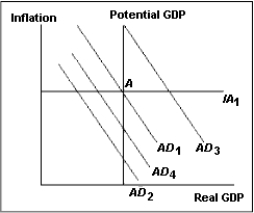Multiple Choice
Suppose the economy is initially in equilibrium at point A in the figure below. A decrease in investment expenditures causes the AD curve to shift back to AD2. Under these circumstances, which of the following statements is true? 
A) If the countercyclical fiscal policy is made at the correct time, the AD curve will shift to AD4.
B) If there is no countercyclical fiscal policy, the AD curve will shift to AD4.
C) If there is no countercyclical fiscal policy, the AD curve will shift back to AD1.
D) If the countercyclical fiscal policy is timely enough, the AD curve will shift to AD3.
E) If there is no countercyclical fiscal policy, the IA line will shift up.
Correct Answer:

Verified
Correct Answer:
Verified
Q93: If real GDP equals B in the
Q94: The whole budget cycle takes<br>A)the same amount
Q95: For a hypothetical economy in 2010, the
Q96: The debt to GDP ratio grows every
Q97: Why is there an inverse relationship between
Q99: The U.S. federal budget is a<br>A)document that
Q100: Which of the following is true?<br>A)Though not
Q101: The U.S. federal budget is a major
Q102: For real and potential GDP to be
Q103: When tax revenues are equal to spending,